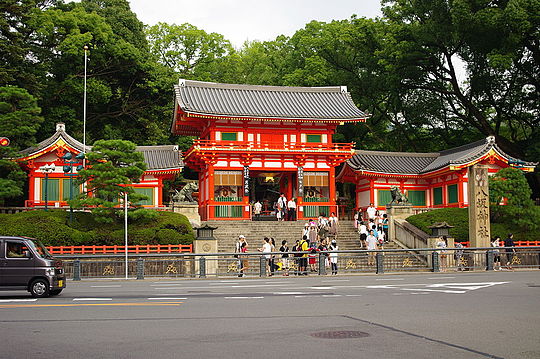

Nishi-Roumon Gate / Yasaka Shrine
The Nishiroumon gate is an important gate located on the west side of Yasaka Shrine, facing Shijo Dori. The gate is one of the shrine's most iconic structures, distinguished by its imposing appearance and vivid vermilion color. The Nishiroumon gate serves as the main entrance to the shrine, and many worshippers pass through this gate to enter the sacred precincts of the shrine. Although the Yasaka Shrine itself dates back to ancient times, it took a long time before the Nishiro-mon Gate took on its present appearance. This gate was rebuilt during the Edo period and is recorded as having been completed in 1825. The reconstruction at that time was funded by donations from wealthy merchants and influential people in Kyoto, indicating the importance of Yasaka Shrine to the citizens of Kyoto. As an Edo period structure, the Nishiroumon gate was influenced by the splendid architectural style of the Momoyama period. In particular, the vermilion-lacquered pillars and gilded decoration demonstrate the high level of skill and aesthetics in shrine architecture. These decorations visually express the sanctity and solemnity of Shintoism, while at the same time making a deep impression on visitors. Yasaka Shrine and its gate are closely associated with the Gion faith, which spread throughout Japan from the Heian period. This belief aimed to drive away plague and disease, and Yasaka Shrine played a central role in this belief. As the Gion Festival developed into an important event among the citizens of Kyoto, the Nishiroumon gate also became familiar to many people and established its status as a sacred place. During the Meiji period, the Yasaka Shrine was renamed from “Gion Shrine” and reorganized as a Shinto shrine in accordance with the Shinto/Buddhist Separation Order. During this period, the Nishiro-mon gate also had its position reaffirmed, and its role as the entrance to the shrine precincts was emphasized more. Furthermore, in the postwar cultural asset protection policy, Nishiroumon was recognized for its historical value and protected as a National Important Cultural Property. Today, Nishiroumon welcomes many tourists and worshippers not only as an architectural structure but also as part of the cultural and historical symbolism of Kyoto. Its magnificent appearance attracts visitors as a place to experience the history and traditions of the ancient capital. Once inside the gate, visitors can experience the ancient Gion faith and the beauty of Japanese architecture, and the temple truly serves as a “gateway to history.